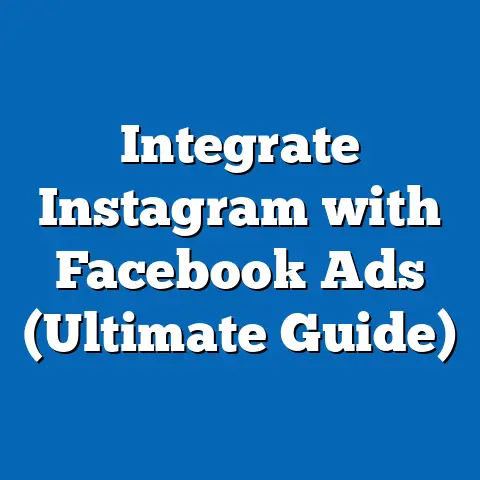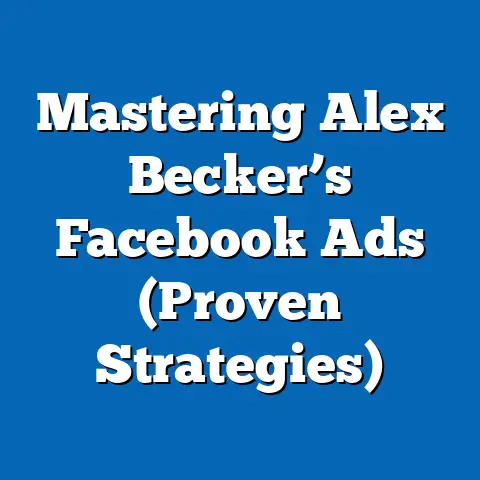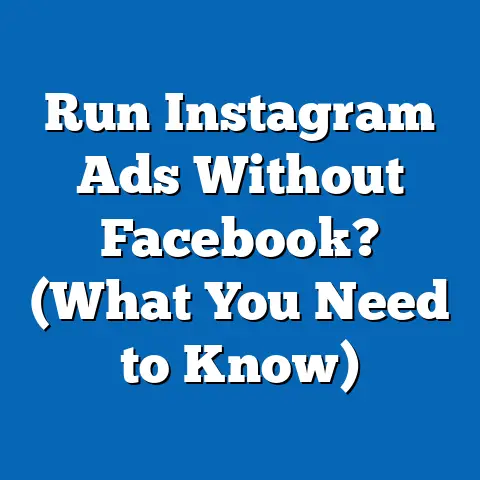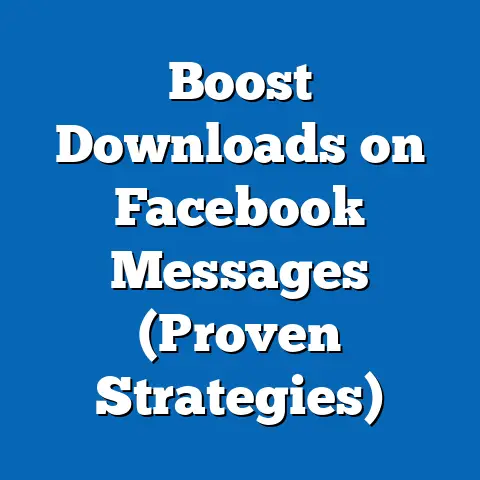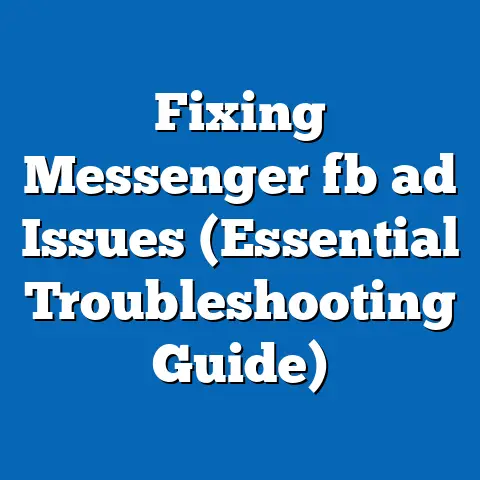Unlock Hidden Potential with Facebook Ads (Expert Strategies)
Imagine a treasure chest filled with gold coins, each representing an opportunity for businesses to reach their ideal audience. This chest is buried within the expansive landscape of social media, specifically within Facebook Ads. Just like a skilled treasure hunter knows how to read maps and decipher clues, marketers must learn to navigate Facebook’s advertising platform to uncover the hidden potential that lies beneath. Facebook Ads can be a powerful tool for businesses of all sizes, giving them the ability to target specific demographics, engage with potential customers, and ultimately drive sales. But simply throwing money at Facebook and hoping for the best rarely works. It requires a deep understanding of the platform’s intricacies to truly harness its full power and unlock significant business growth.
I’ve spent years working with Facebook Ads, and I’ve seen firsthand how transformative they can be for businesses that learn to leverage them correctly. I’ve also seen plenty of campaigns fail miserably because of a lack of understanding of the fundamentals. This guide is designed to give you the tools and knowledge you need to navigate the Facebook Ads landscape effectively, avoid common pitfalls, and unlock the hidden potential within the platform. Let’s dive in!
Understanding Facebook’s Advertising Ecosystem
The first step in mastering Facebook Ads is understanding its structure. Think of it as a pyramid, with each level building upon the one below:
-
Campaigns: This is the highest level, where you define your overall advertising objective. Are you looking to increase brand awareness, drive traffic to your website, generate leads, or boost sales? Choosing the right campaign objective is crucial because it tells Facebook what you want to achieve, and the algorithm will optimize your ad delivery accordingly.
- Example: I once worked with a local bakery that wanted to increase online orders. We created a “Conversions” campaign optimized for online purchases, which proved far more effective than a general “Traffic” campaign we initially tested.
-
Ad Sets: Within each campaign, you create ad sets. This is where you define your target audience, budget, bidding strategy, and ad schedule. Ad sets allow you to segment your audience and tailor your message to different groups.
-
Example: If you’re selling clothing, you might create separate ad sets targeting men and women, or different age groups, with ads that feature products they are most likely to be interested in.
-
Ads: At the bottom of the pyramid are the individual ads themselves. This is where you create the actual content that your audience will see, including the headline, body text, images, videos, and call to action.
-
Example: Within your “Women’s Clothing” ad set, you could have multiple ads featuring different styles of dresses, each with a compelling headline and a clear call to action like “Shop Now” or “Learn More.”
Campaigns: This is the highest level, where you define your overall advertising objective. Are you looking to increase brand awareness, drive traffic to your website, generate leads, or boost sales? Choosing the right campaign objective is crucial because it tells Facebook what you want to achieve, and the algorithm will optimize your ad delivery accordingly.
- Example: I once worked with a local bakery that wanted to increase online orders. We created a “Conversions” campaign optimized for online purchases, which proved far more effective than a general “Traffic” campaign we initially tested.
-
Ad Sets: Within each campaign, you create ad sets. This is where you define your target audience, budget, bidding strategy, and ad schedule. Ad sets allow you to segment your audience and tailor your message to different groups.
-
Example: If you’re selling clothing, you might create separate ad sets targeting men and women, or different age groups, with ads that feature products they are most likely to be interested in.
-
Ads: At the bottom of the pyramid are the individual ads themselves. This is where you create the actual content that your audience will see, including the headline, body text, images, videos, and call to action.
-
Example: Within your “Women’s Clothing” ad set, you could have multiple ads featuring different styles of dresses, each with a compelling headline and a clear call to action like “Shop Now” or “Learn More.”
Ad Sets: Within each campaign, you create ad sets. This is where you define your target audience, budget, bidding strategy, and ad schedule. Ad sets allow you to segment your audience and tailor your message to different groups.
Example: If you’re selling clothing, you might create separate ad sets targeting men and women, or different age groups, with ads that feature products they are most likely to be interested in.
Ads: At the bottom of the pyramid are the individual ads themselves. This is where you create the actual content that your audience will see, including the headline, body text, images, videos, and call to action.
Example: Within your “Women’s Clothing” ad set, you could have multiple ads featuring different styles of dresses, each with a compelling headline and a clear call to action like “Shop Now” or “Learn More.”
The Significance of Audience Targeting
Facebook’s audience targeting capabilities are one of its greatest strengths. You can target users based on a vast array of factors, including:
-
Demographics: Age, gender, location, education, relationship status, and more.
- Insight: Don’t assume you know your audience. I’ve often been surprised by the demographics that respond best to certain ads. Always test different demographics to see what works.
-
Interests: Hobbies, interests, pages they’ve liked, groups they’ve joined, and more.
-
Tip: Use Facebook’s Audience Insights tool to discover the interests of your target audience. You might uncover unexpected interests that you can use to refine your targeting.
-
Behaviors: Past purchase behavior, device usage, travel habits, and more.
-
Example: You can target users who have recently purchased products similar to yours, or those who are frequent travelers.
-
Custom Audiences: These are audiences you create based on your own data, such as email lists, website visitors, or app users.
-
Power Tip: Custom Audiences are incredibly powerful for retargeting. You can show ads to people who have already interacted with your business, increasing the likelihood of conversion.
-
Lookalike Audiences: These are audiences that Facebook creates based on your Custom Audiences. Facebook identifies users who share similar characteristics to your existing customers, allowing you to reach new potential customers who are likely to be interested in your products or services.
-
My Experience: I once used a Lookalike Audience based on my top 1% of customers, and it generated a 3x higher conversion rate than any other audience I had tested.
Demographics: Age, gender, location, education, relationship status, and more.
- Insight: Don’t assume you know your audience. I’ve often been surprised by the demographics that respond best to certain ads. Always test different demographics to see what works.
-
Interests: Hobbies, interests, pages they’ve liked, groups they’ve joined, and more.
-
Tip: Use Facebook’s Audience Insights tool to discover the interests of your target audience. You might uncover unexpected interests that you can use to refine your targeting.
-
Behaviors: Past purchase behavior, device usage, travel habits, and more.
-
Example: You can target users who have recently purchased products similar to yours, or those who are frequent travelers.
-
Custom Audiences: These are audiences you create based on your own data, such as email lists, website visitors, or app users.
-
Power Tip: Custom Audiences are incredibly powerful for retargeting. You can show ads to people who have already interacted with your business, increasing the likelihood of conversion.
-
Lookalike Audiences: These are audiences that Facebook creates based on your Custom Audiences. Facebook identifies users who share similar characteristics to your existing customers, allowing you to reach new potential customers who are likely to be interested in your products or services.
-
My Experience: I once used a Lookalike Audience based on my top 1% of customers, and it generated a 3x higher conversion rate than any other audience I had tested.
Interests: Hobbies, interests, pages they’ve liked, groups they’ve joined, and more.
Tip: Use Facebook’s Audience Insights tool to discover the interests of your target audience. You might uncover unexpected interests that you can use to refine your targeting.
Behaviors: Past purchase behavior, device usage, travel habits, and more.
Example: You can target users who have recently purchased products similar to yours, or those who are frequent travelers.
Custom Audiences: These are audiences you create based on your own data, such as email lists, website visitors, or app users.
Power Tip: Custom Audiences are incredibly powerful for retargeting. You can show ads to people who have already interacted with your business, increasing the likelihood of conversion.
Lookalike Audiences: These are audiences that Facebook creates based on your Custom Audiences. Facebook identifies users who share similar characteristics to your existing customers, allowing you to reach new potential customers who are likely to be interested in your products or services.
My Experience: I once used a Lookalike Audience based on my top 1% of customers, and it generated a 3x higher conversion rate than any other audience I had tested.
Understanding Facebook’s Algorithm
Facebook’s algorithm determines which ads are shown to which users. It’s a complex and constantly evolving system, but here are some key factors that influence ad delivery:
-
Bid: How much you’re willing to pay for each impression or click.
- Strategy: Don’t always bid the highest. A well-targeted ad with high engagement can often win against a higher-bidding, less relevant ad.
-
Relevance Score: A score from 1 to 10 that Facebook assigns to your ad based on how relevant it is to your target audience.
-
Important: A high Relevance Score means your ad is resonating with your audience, which leads to lower costs and better performance.
-
Estimated Action Rates: Facebook’s prediction of how likely users are to take the desired action (e.g., click, purchase) after seeing your ad.
-
Actionable Tip: Optimize your ad creative and landing page to increase the likelihood of users taking the desired action.
- Ad Quality: The overall quality of your ad, including the visuals, copy, and landing page experience.
Bid: How much you’re willing to pay for each impression or click.
- Strategy: Don’t always bid the highest. A well-targeted ad with high engagement can often win against a higher-bidding, less relevant ad.
-
Relevance Score: A score from 1 to 10 that Facebook assigns to your ad based on how relevant it is to your target audience.
-
Important: A high Relevance Score means your ad is resonating with your audience, which leads to lower costs and better performance.
-
Estimated Action Rates: Facebook’s prediction of how likely users are to take the desired action (e.g., click, purchase) after seeing your ad.
-
Actionable Tip: Optimize your ad creative and landing page to increase the likelihood of users taking the desired action.
- Ad Quality: The overall quality of your ad, including the visuals, copy, and landing page experience.
Relevance Score: A score from 1 to 10 that Facebook assigns to your ad based on how relevant it is to your target audience.
Important: A high Relevance Score means your ad is resonating with your audience, which leads to lower costs and better performance.
Estimated Action Rates: Facebook’s prediction of how likely users are to take the desired action (e.g., click, purchase) after seeing your ad.
Actionable Tip: Optimize your ad creative and landing page to increase the likelihood of users taking the desired action.
Success Story: A Local Bookstore
I worked with a local bookstore that was struggling to compete with online retailers. By understanding Facebook’s advertising ecosystem, we were able to turn things around. We started by creating a “Traffic” campaign targeted at local residents interested in books and literature. We then created a Custom Audience based on their email list and a Lookalike Audience based on their best customers. Their ads featured beautiful images of the bookstore’s interior and highlighted upcoming events. The result? A significant increase in foot traffic and online sales.
Key Takeaways:
- Understand the structure of Facebook Ads: Campaigns, Ad Sets, and Ads.
- Leverage Facebook’s powerful audience targeting capabilities.
- Understand how Facebook’s algorithm works and optimize your ads accordingly.
Next Steps:
- Familiarize yourself with the Facebook Ads Manager interface.
- Experiment with different targeting options to see what works best for your business.
- Start small and gradually increase your budget as you gain confidence.
Crafting Compelling Ad Content
Now that you understand the basics of the Facebook Ads ecosystem, let’s talk about creating ad content that grabs attention and drives results. Your ad creative is the first thing people will see, so it needs to be visually appealing, relevant, and engaging.
The Vital Elements of Ad Copy
-
Headline: The headline is the first thing people will read, so it needs to be attention-grabbing and concise.
- Best Practice: Keep your headlines short and sweet. Aim for 25-40 characters. Use strong verbs and numbers to make your headline more compelling.
-
Body Text: The body text provides more detail about your product or service.
-
Tip: Focus on the benefits, not just the features. Explain how your product or service will solve your audience’s problems or improve their lives.
-
Call to Action (CTA): The CTA tells people what you want them to do next.
-
Insight: Use clear and specific CTAs, such as “Shop Now,” “Learn More,” “Sign Up,” or “Get Started.” A/B test different CTAs to see which ones perform best.
Headline: The headline is the first thing people will read, so it needs to be attention-grabbing and concise.
- Best Practice: Keep your headlines short and sweet. Aim for 25-40 characters. Use strong verbs and numbers to make your headline more compelling.
-
Body Text: The body text provides more detail about your product or service.
-
Tip: Focus on the benefits, not just the features. Explain how your product or service will solve your audience’s problems or improve their lives.
-
Call to Action (CTA): The CTA tells people what you want them to do next.
-
Insight: Use clear and specific CTAs, such as “Shop Now,” “Learn More,” “Sign Up,” or “Get Started.” A/B test different CTAs to see which ones perform best.
Body Text: The body text provides more detail about your product or service.
Tip: Focus on the benefits, not just the features. Explain how your product or service will solve your audience’s problems or improve their lives.
Call to Action (CTA): The CTA tells people what you want them to do next.
Insight: Use clear and specific CTAs, such as “Shop Now,” “Learn More,” “Sign Up,” or “Get Started.” A/B test different CTAs to see which ones perform best.
The Importance of Visuals
Visuals are crucial for capturing attention on Facebook.
-
Images: Use high-quality images that are relevant to your product or service.
- Pro Tip: Use images that are visually appealing and evoke emotion. Avoid stock photos that look generic.
-
Videos: Videos are even more engaging than images. Use videos to showcase your product, tell a story, or provide valuable information.
-
My Experience: I created a short video ad for a client that featured customer testimonials, and it generated a 5x higher conversion rate than their static image ads.
-
Carousel Ads: Carousel ads allow you to showcase multiple products or features in a single ad.
-
Strategy: Use carousel ads to tell a story or highlight different aspects of your product or service.
- Collection Ads: Collection ads are designed for e-commerce businesses. They allow you to showcase a collection of products in a visually appealing format.
Images: Use high-quality images that are relevant to your product or service.
- Pro Tip: Use images that are visually appealing and evoke emotion. Avoid stock photos that look generic.
-
Videos: Videos are even more engaging than images. Use videos to showcase your product, tell a story, or provide valuable information.
-
My Experience: I created a short video ad for a client that featured customer testimonials, and it generated a 5x higher conversion rate than their static image ads.
-
Carousel Ads: Carousel ads allow you to showcase multiple products or features in a single ad.
-
Strategy: Use carousel ads to tell a story or highlight different aspects of your product or service.
- Collection Ads: Collection ads are designed for e-commerce businesses. They allow you to showcase a collection of products in a visually appealing format.
Videos: Videos are even more engaging than images. Use videos to showcase your product, tell a story, or provide valuable information.
My Experience: I created a short video ad for a client that featured customer testimonials, and it generated a 5x higher conversion rate than their static image ads.
Carousel Ads: Carousel ads allow you to showcase multiple products or features in a single ad.
Strategy: Use carousel ads to tell a story or highlight different aspects of your product or service.
Storytelling: Creating Emotional Connections
People are more likely to remember and engage with ads that tell a story.
- Example: Instead of simply listing the features of your product, tell a story about how it has helped someone solve a problem or achieve a goal.
Case Study: A Fitness Studio
I worked with a fitness studio that was struggling to attract new members. Their initial ads were generic and uninspiring. We decided to focus on storytelling. We created ads that featured real members sharing their personal fitness journeys. The ads highlighted the positive impact that the studio had had on their lives, both physically and mentally. The result? A significant increase in new memberships.
Key Takeaways:
- Craft compelling ad copy with attention-grabbing headlines, benefit-focused body text, and clear CTAs.
- Use high-quality visuals that are relevant to your product or service.
- Tell stories that create emotional connections with your audience.
Next Steps:
- Experiment with different ad formats and visuals.
- A/B test different ad copy and CTAs.
- Focus on telling stories that resonate with your target audience.
Utilizing Data and Analytics for Optimization
Facebook Ads Manager is your command center for managing and optimizing your campaigns. It provides a wealth of data and analytics that you can use to improve your ad performance.
Facebook Ads Manager: Your Reporting Hub
- Key Metrics:
-
Impressions: The number of times your ad was shown.
-
Insight: Track impressions to understand your ad’s reach.
- Reach: The number of unique people who saw your ad.
-
Important: Reach helps you understand how many new people you are reaching.
- Clicks: The number of times people clicked on your ad.
-
Tip: A high click-through rate (CTR) indicates that your ad is relevant and engaging.
- Click-Through Rate (CTR): The percentage of people who clicked on your ad after seeing it.
-
Benchmark: A good CTR is typically above 1%.
- Conversion Rate: The percentage of people who took the desired action (e.g., purchase, sign up) after clicking on your ad.
-
Strategy: Optimize your landing page to improve your conversion rate.
- Cost Per Acquisition (CPA): The cost of acquiring a new customer or lead.
-
Goal: Lower your CPA by optimizing your ads and targeting.
- Return on Ad Spend (ROAS): The amount of revenue you generate for every dollar you spend on advertising.
-
Measure: ROAS is a key indicator of your campaign’s profitability.
-
-
-
Impressions: The number of times your ad was shown.
-
Insight: Track impressions to understand your ad’s reach.
- Reach: The number of unique people who saw your ad.
-
Important: Reach helps you understand how many new people you are reaching.
- Clicks: The number of times people clicked on your ad.
-
Tip: A high click-through rate (CTR) indicates that your ad is relevant and engaging.
- Click-Through Rate (CTR): The percentage of people who clicked on your ad after seeing it.
-
Benchmark: A good CTR is typically above 1%.
- Conversion Rate: The percentage of people who took the desired action (e.g., purchase, sign up) after clicking on your ad.
-
Strategy: Optimize your landing page to improve your conversion rate.
- Cost Per Acquisition (CPA): The cost of acquiring a new customer or lead.
-
Goal: Lower your CPA by optimizing your ads and targeting.
- Return on Ad Spend (ROAS): The amount of revenue you generate for every dollar you spend on advertising.
-
Measure: ROAS is a key indicator of your campaign’s profitability.
-
Impressions: The number of times your ad was shown.
-
Insight: Track impressions to understand your ad’s reach.
- Reach: The number of unique people who saw your ad.
-
Important: Reach helps you understand how many new people you are reaching.
- Clicks: The number of times people clicked on your ad.
-
Tip: A high click-through rate (CTR) indicates that your ad is relevant and engaging.
- Click-Through Rate (CTR): The percentage of people who clicked on your ad after seeing it.
-
Benchmark: A good CTR is typically above 1%.
- Conversion Rate: The percentage of people who took the desired action (e.g., purchase, sign up) after clicking on your ad.
-
Strategy: Optimize your landing page to improve your conversion rate.
- Cost Per Acquisition (CPA): The cost of acquiring a new customer or lead.
-
Goal: Lower your CPA by optimizing your ads and targeting.
- Return on Ad Spend (ROAS): The amount of revenue you generate for every dollar you spend on advertising.
-
Measure: ROAS is a key indicator of your campaign’s profitability.
Insight: Track impressions to understand your ad’s reach.
- Reach: The number of unique people who saw your ad.
Important: Reach helps you understand how many new people you are reaching.
- Clicks: The number of times people clicked on your ad.
Tip: A high click-through rate (CTR) indicates that your ad is relevant and engaging.
- Click-Through Rate (CTR): The percentage of people who clicked on your ad after seeing it.
Benchmark: A good CTR is typically above 1%.
- Conversion Rate: The percentage of people who took the desired action (e.g., purchase, sign up) after clicking on your ad.
Strategy: Optimize your landing page to improve your conversion rate.
- Cost Per Acquisition (CPA): The cost of acquiring a new customer or lead.
Goal: Lower your CPA by optimizing your ads and targeting.
- Return on Ad Spend (ROAS): The amount of revenue you generate for every dollar you spend on advertising.
Measure: ROAS is a key indicator of your campaign’s profitability.
A/B Testing: Finding What Works Best
A/B testing involves creating two or more versions of an ad and testing them against each other to see which one performs best.
- Example: You could A/B test different headlines, images, or CTAs.
Pixel Tracking and Event Tracking
The Facebook Pixel is a piece of code that you install on your website. It allows you to track the actions that people take on your website after clicking on your ad.
- Power Move: Use pixel tracking to create Custom Audiences based on website visitors and retarget them with relevant ads.
Case Study: An E-Commerce Store
I worked with an e-commerce store that was struggling to generate sales through Facebook Ads. By implementing pixel tracking and event tracking, we were able to gain valuable insights into their customer journey. We discovered that many people were adding products to their cart but not completing the purchase. We then created retargeting ads that showed these people the products they had added to their cart, with a special offer to encourage them to complete the purchase. The result? A significant increase in sales.
Key Takeaways:
- Use Facebook Ads Manager to track your ad performance.
- A/B test different ad elements to find what works best.
- Implement pixel tracking and event tracking to gain valuable insights into your customer journey.
Next Steps:
- Set up pixel tracking on your website.
- Start A/B testing different ad elements.
- Use the data you collect to optimize your campaigns for better ROI.
Advanced Targeting Techniques
Once you’ve mastered the basics of Facebook Ads, you can start exploring advanced targeting techniques to reach even more specific audiences and improve your ad performance.
Retargeting: Reaching People Who Have Already Interacted with Your Business
Retargeting involves showing ads to people who have already visited your website, watched your videos, or engaged with your Facebook page.
- My Experience: Retargeting campaigns consistently outperform other types of campaigns because you’re targeting people who are already familiar with your brand.
Dynamic Ads: Showcasing Relevant Products to Individual Users
Dynamic ads are designed for e-commerce businesses. They automatically show users products that they have previously viewed on your website.
- Example: If someone visits your website and looks at a specific pair of shoes, a dynamic ad will show them that exact pair of shoes in their Facebook feed.
Behavioral Data: Targeting Users Based on Their Past Actions
Facebook collects a vast amount of data on its users, including their past purchase behavior, device usage, travel habits, and more. You can use this data to target users based on their specific interests and behaviors.
- Insight: Be careful not to be too creepy. Avoid targeting users based on sensitive information, such as their health conditions or political affiliations.
Audience Segmentation: Creating Personalized Advertising Experiences
Audience segmentation involves dividing your target audience into smaller groups based on their demographics, interests, and behaviors.
- Strategy: Segment your audience based on their stage in the customer journey. Show different ads to people who are just learning about your brand than to those who are ready to make a purchase.
Facebook Insights: Identifying Trends Within Target Demographics
Facebook Insights provides valuable data about your target audience, including their demographics, interests, and behaviors. You can use this data to identify trends and tailor your ads accordingly.
- Tip: Pay attention to the pages that your target audience likes and the topics that they discuss. This can give you valuable insights into their interests and motivations.
Case Study: A Subscription Box Company
I worked with a subscription box company that was struggling to acquire new subscribers. By implementing advanced targeting techniques, we were able to significantly improve their subscriber acquisition rate. We created retargeting ads that showed people who had visited their website but not subscribed. We also used dynamic ads to show people different subscription boxes based on their interests. The result? A significant increase in new subscribers.
Key Takeaways:
- Use retargeting to reach people who have already interacted with your business.
- Implement dynamic ads to showcase relevant products to individual users.
- Leverage behavioral data to target users based on their past actions.
- Segment your audience to create personalized advertising experiences.
- Use Facebook Insights to identify trends within your target demographics.
Next Steps:
- Explore advanced targeting options in Facebook Ads Manager.
- Experiment with different audience segments.
- Use Facebook Insights to gain a deeper understanding of your target audience.
Conclusion
Facebook Ads offer incredible potential for businesses to unlock growth, but it requires more than just setting a budget and hoping for the best. It demands a strategic approach, a deep understanding of the platform’s ecosystem, compelling ad content, data-driven optimization, and the willingness to experiment with advanced targeting techniques.
The world of Facebook Ads is constantly evolving, so it’s crucial to stay up-to-date on the latest trends and best practices. Don’t be afraid to try new things and learn from your mistakes.
I encourage you to view Facebook Ads not as an expense, but as an investment in your business’s future success. Take action, experiment with the strategies outlined in this article, and unlock the hidden potential that Facebook Ads holds for your business. You might be surprised at what you can achieve!

